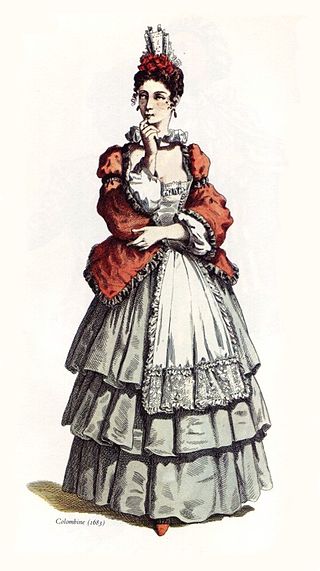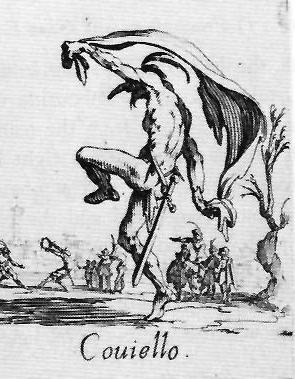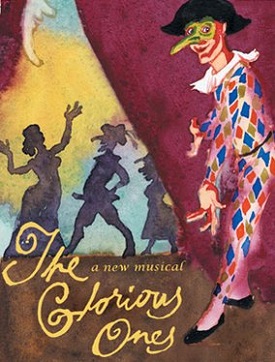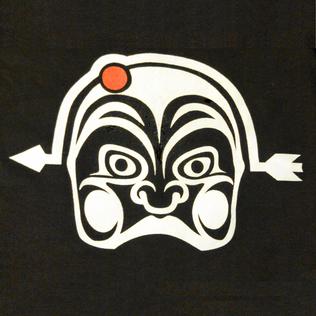
Harlequin is the best-known of the comic servant characters (Zanni) from the Italian commedia dell'arte, associated with the city of Bergamo. The role is traditionally believed to have been introduced by the Italian actor-manager Zan Ganassa in the late 16th century, was definitively popularized by the Italian actor Tristano Martinelli in Paris in 1584–1585, and became a stock character after Martinelli's death in 1630.

Zanni, Zani or Zane is a character type of commedia dell'arte best known as an astute servant and a trickster. The Zanni comes from the countryside and is known to be a "dispossessed immigrant worker". Through time, the Zanni grew to be a popular figure who was first seen in commedia as early as the 14th century. The English word zany derives from this character. The longer the nose on the characters mask, the more foolish the character.

Brighella is a comic, masked character from the Italian theatre style commedia dell'arte. His early costume consisted of loosely fitting, white smock and pants with green trim and was often equipped with a batocio or slapstick, or else with a wooden sword. Later he took to wearing a sort of livery with a matching cape. He wore a greenish half-mask displaying a look of preternatural lust and greed. It is distinguished by a hook nose and thick lips, along with a thick twirled mustache to give him an offensive characteristic. He evolved out of the general Zanni, as evidenced by his costume, and came into his own around the start of the 16th century.

Columbina is a stock character in the commedia dell'arte. She is Harlequin's mistress, a comic servant playing the tricky slave type, and wife of Pierrot. Rudlin and Crick use the Italian spelling Colombina in Commedia dell'Arte: A Handbook for Troupes.
La Ruffiana is an older female character of the Commedia dell'Arte with a shady past or who used to be a prostitute. She is used most often in relationship to the vecchi of which group she is a nominal member. Ruffiana is most often romantically involved with Pantalone, though his love may easily be unrequited if it suits the plot. She is generally described as being talkative/gossipy, sneaky, and mischievous, but deep down is actually kind. She has been described as an "outsider" that always mixes things up and causes trouble for the rest of the characters. "Her quips reek of garlic"

Innamorati were stock characters within the theatre style known as commedia dell'arte, who appeared in 16th-century Italy. In the plays, everything revolved around the lovers in some regard. These dramatic and posh characters were present within commedia plays for the sole purpose of being in love with one another, and moreover, with themselves. These characters move elegantly and smoothly, and their young faces are unmasked unlike other commedia dell'arte characters. Despite facing many obstacles, the lovers were always united by the end.
Vecchio is a category of aged, male characters from Italian commedia dell'arte theatre. The primary members of this group are Pantalone, Il Dottore, and Il Capitano. Pantalone and Il Dottore are the alter ego of each other: Pantalone being the decadent wealthy merchant, and Il Dottore being the decadent erudite.

Pantalone, spelled Pantaloon in English, is one of the most important principal characters found in commedia dell'arte. With his exceptional greed and status at the top of the social order, Pantalone is "money" in the commedia world. His full name, including family name, is Pantalon de' Bisognosi, Italian for 'Pantalone of the Needy'.

Il Capitano is one of the four stock characters of commedia dell'arte. He most likely was never a "Captain", but rather appropriated the name for himself.
Il Dottore, most commonly known in Italian as Dottor Balan or simply Balanzone, is a commedia dell'arte stock character, in one scenario being an obstacle to young lovers. Il Dottore and Pantalone are the comic foils of each other, Pantalone being the decadent wealthy merchant, and Il Dottore being the decadent erudite. He has been part of the main canon of characters since the mid-16th century.

Pulcinella is a classical character that originated in commedia dell'arte of the 17th century and became a stock character in Neapolitan puppetry. Pulcinella's versatility in status and attitude has captivated audiences worldwide and kept the character popular in countless forms since his introduction to commedia dell'arte by Silvio Fiorillo in 1620.

The Carnival of Venice is an annual festival held in Venice, Italy, famous throughout the world for its elaborate costumes and masks. The Carnival ends on Shrove Tuesday, which is the day before the start of Lent on Ash Wednesday.

The Servant of Two Masters is a comedy by the Italian playwright Carlo Goldoni written in 1746. Goldoni originally wrote the play at the request of actor Antonio Sacco, one of the great Harlequins in history. His earliest drafts had large sections that were reserved for improvisation, but he revised it in 1789 in the version that exists today. The play draws on the tradition of the earlier Italian commedia dell'arte.

Pedrolino is a primo ("first") Zanni, or comic servant, of the commedia dell'arte; the name is a hypocorism of Pedro (Peter), via the suffix -lino. The character made its first appearance in the last quarter of the 16th century, apparently as the invention of the actor with whom the role was to be long identified, Giovanni Pellesini. Contemporary illustrations suggest that his white blouse and trousers constituted "a variant of the typical Zanni suit", and his Bergamasque dialect marked him as a member of the "low" rustic class. But if his costume and social station were without distinction, his dramatic role was certainly not: as a multifaceted first Zanni, his character was—and still is—rich in comic incongruities.

Coviello is a minor character in the commedia dell'arte. He falls into the category of the Zanni. His name is a double diminutive of the name Giacomo. In English, he might be called Jimmy or Jackie.

Burattino, also Burrattino or Burratino, is a minor commedia dell'arte character of the Zanni class.

The Glorious Ones is a musical with book and lyrics by Lynn Ahrens and music by Stephen Flaherty. Set in 17th-century Italy, it concerns a theatre group in the world of commedia dell'arte and theatre of the Italian Renaissance.

Commedia dell'arte was an early form of professional theatre, originating from Italian theatre, that was popular throughout Europe between the 16th and 18th centuries. It was formerly called Italian comedy in English and is also known as commedia alla maschera, commedia improvviso, and commedia dell'arte all'improvviso. Characterized by masked "types", commedia was responsible for the rise of actresses such as Isabella Andreini and improvised performances based on sketches or scenarios. A commedia, such as The Tooth Puller, is both scripted and improvised. Characters' entrances and exits are scripted. A special characteristic of commedia is the lazzo, a joke or "something foolish or witty", usually well known to the performers and to some extent a scripted routine. Another characteristic of commedia is pantomime, which is mostly used by the character Arlecchino, now better known as Harlequin.

i Sebastiani is a Commedia dell'Arte theatre troupe formed in 1990 by Jeff Hatalsky. To the present day, i Sebastiani has performed for thousands of fans across the United States and Canada. The company has travelled as far as Montreal to the north, Miami to the south, and Texas to the west, performing more than 100 different improvisational scenarios.

Each character in commedia dell'arte is distinctly different, and defined by their movement, actions, masks, and costumes. These costumes show their social status and background.

















